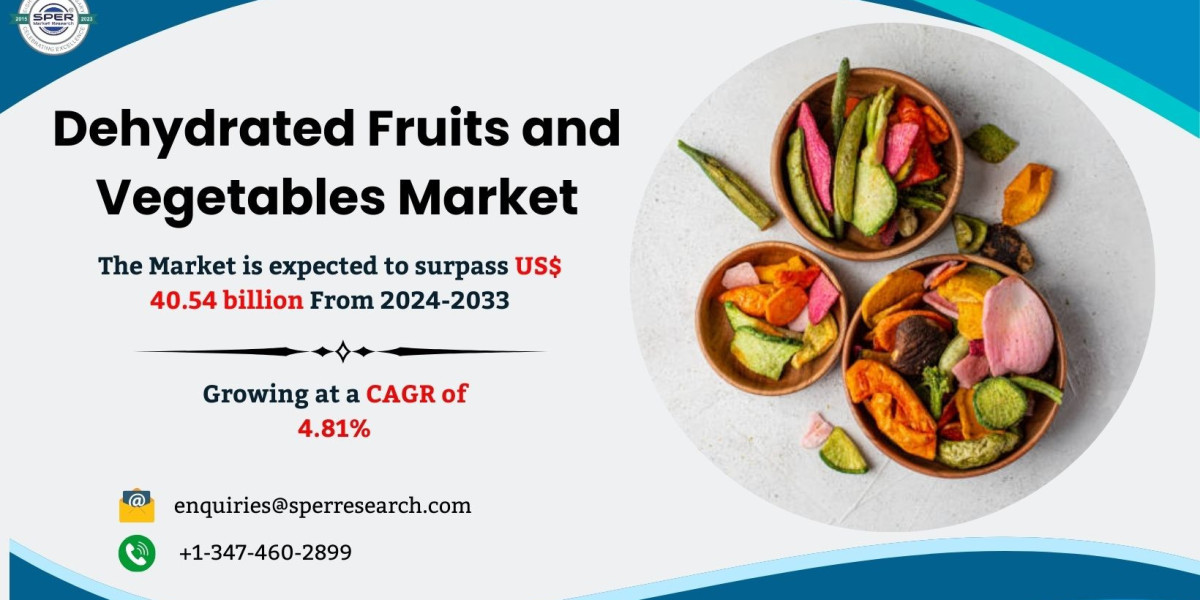Market Overview and Market Insights: Reducing the water content in fruits and vegetables through various drying methods—such as air drying, freeze drying, and sun drying—helps retain most of their nutrients, flavours, and textures. This process not only extends the shelf life of the produce but also makes it easier to store and transport, offering a practical solution for long-term use. Dehydrated fruits and vegetables serve as nutritious alternatives to fresh produce and are widely used in soups, snacks, cereals, and ready-made meals. Their portability and rich content of vitamins, minerals, and fibre make them especially popular among health-conscious individuals and outdoor enthusiasts. Additionally, the dehydration process minimizes waste by preserving seasonal produce for use throughout the year.
According to SPER Market Research, the report titled ‘Global Dehydrated Fruits and Vegetables Market Size - By Product Type, By Product, By Distribution Channel - Regional Outlook, Competitive Strategies, and Segment Forecast to 2033’ projects that the global market for dehydrated fruits and vegetables will reach a valuation of USD 40.54 billion by 2033, with a compound annual growth rate (CAGR) of 4.81%.
Market Drivers: The growing demand for nutrient-rich, long-lasting, and easy-to-use food products is a key factor driving the global market for dehydrated fruits and vegetables. This demand is especially evident among health-conscious consumers and those leading busy lifestyles, as the convenience of dehydrated products for storage and transportation makes them highly appealing. Rising interest in reducing food waste and addressing global food security concerns also contributes to market growth, as dehydration prolongs the shelf life of produce. Additionally, advancements in drying technologies, which help maintain the flavor and nutritional quality of foods, further boost adoption. The increasing use of dehydrated ingredients in processed foods, snacks, and beverages across the retail and foodservice industries is another significant growth driver.
Download sample PDF copy of this report to understand structure of the complete report @ https://www.sperresearch.com/report-store/dehydrated-fruits-and-vegetables-market.aspx?sample=1
Market Restraints: Despite its benefits, the dehydrated fruits and vegetables market faces challenges, including the high cost of advanced drying methods, which can increase product prices and affect affordability. Maintaining the flavor and nutritional content during the dehydration process can also be difficult, as some methods may lead to nutrient loss or altered taste. Seasonal and climatic variability impacting raw material availability can disrupt production consistency. Furthermore, regional preferences for fresh produce and limited awareness of the benefits of dehydrated foods hinder market growth. Stringent food safety regulations and compliance requirements add another layer of complexity to production processes.
Impact of COVID-19: The COVID-19 pandemic had a significant impact on the global dehydrated fruits and vegetables market. Initially, lockdowns, supply chain disruptions, and labor shortages posed challenges to production and distribution. However, the pandemic also drove increased demand for non-perishable food items, as consumers sought durable, nutritious options to ensure food security and reduce trips to the grocery store. Dehydrated fruits and vegetables became increasingly popular for their extended shelf life and preserved nutrients. The sector rebounded as consumer’s prioritized health and convenience during uncertain times, contributing to a renewed focus on immunity-boosting and long-lasting food options.
Key Players: North America leads the global market for dehydrated fruits and vegetables, fueled by a strong consumer preference for convenient and healthy food choices, along with the use of advanced food processing technologies. Key market participants include European Freeze Dry, Ajinomoto Co. Inc., Nutristore Canada, Augason Farms, and Nestlé SA.
Global Dehydrated Fruits and Vegetables Market Segmentation:
By Product Type: Based on the Product Type, Global Dehydrated Fruits and Vegetables Market is segmented as; Spray-Dried, Freeze-Dried, Vacuum-Dried, Sun-Dried, and Others.
By Product: Based on the Product Type, Global Dehydrated Fruits and Vegetables Market is segmented as; Dairy Products, Fruits and Vegetables, Meat and Seafood, Instant Coffee, Dehydrated Prepared Meals, Spices and Herbs, Others.
By Distribution Channel: Based on the Distribution Channel, Global Dehydrated Fruits and Vegetables Market is segmented as; Hypermarket/Supermarket, Convenience Stores, Online Retail Stores, and Other Channels.
By Region: This research also includes data for North America, Asia-Pacific, Latin America, Middle East & Africa, and Europe.
For More Information in Dehydrated Fruits and Vegetables Market, refer to below link –
Dehydrated Fruits and Vegetables Market Share
Others Industry Report –
- United States E-cigarette and Vape Market Growth, Size, Trends Analysis- By Product, By Distribution Channel- Regional Outlook, Competitive Strategies and Segment Forecast to 2033
- Barcode Decoding Software Market Size- By Deployment Mode, By Application- Regional Outlook, Competitive Strategies and Segment Forecast to 2033
- Saudi Arabia Apparel Market Size- By Category- Regional Outlook, Competitive Strategies and Segment Forecast to 2033
Follow Us –
LinkedIn | Instagram | Facebook | Twitter
Contact Us:
Sara Lopes, Business Consultant – U.S.A.
SPER Market Research
+1-347-460-2899










